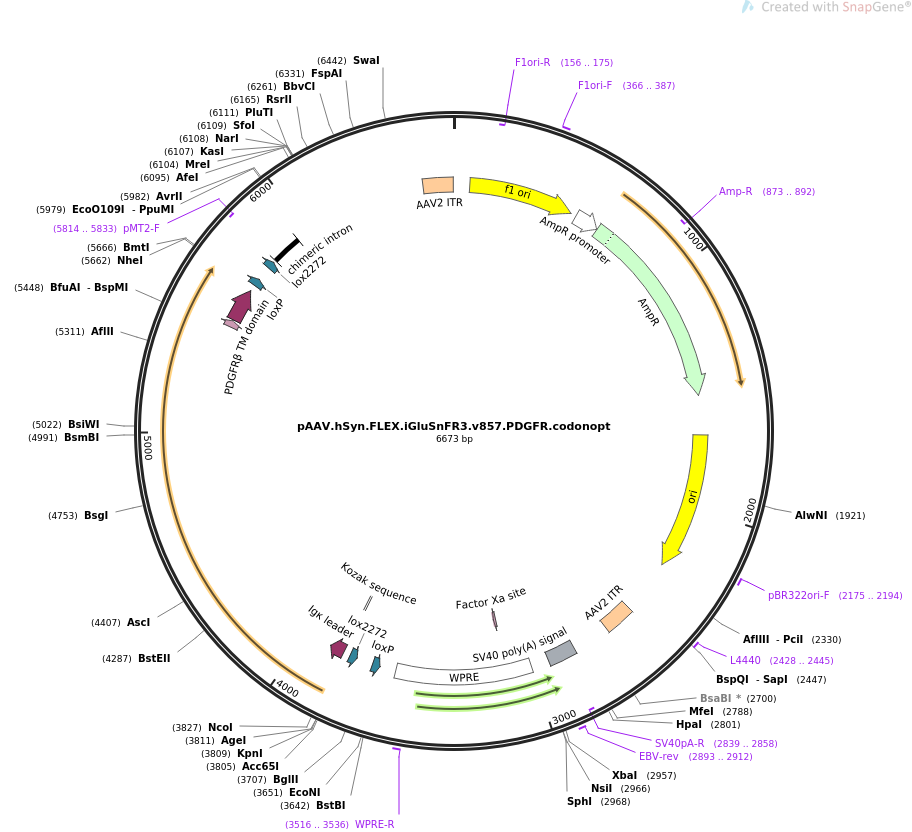-
PurposeFluorescent reporter for glutamate, third generation, variant 857. iGluSnFR3.v857
-
Depositing Lab
-
Sequence Information
Ordering
| Item | Catalog # | Description | Quantity | Price (USD) | |
|---|---|---|---|---|---|
| Plasmid | 175180 | Standard format: Plasmid sent in bacteria as agar stab | 1 | $85 | |
| AAV1 | 175180-AAV1 | Virus (100 µL at titer ≥ 7×10¹² vg/mL) and Plasmid. | $405 | ||
Backbone
-
Vector backbonepAAV hSyn FLEX
- Backbone size w/o insert (bp) 4852
- Total vector size (bp) 6673
-
Vector typeMammalian Expression, Mouse Targeting, AAV, Cre/Lox, Synthetic Biology
Growth in Bacteria
-
Bacterial Resistance(s)Ampicillin, 100 μg/mL
-
Growth Temperature30°C
-
Growth Strain(s)NEB Stable
-
Growth instructions<8 hours
-
Copy numberHigh Copy
Gene/Insert
-
Gene/Insert namepAAV hSyn FLEX iGluSnFR3 v857.PDGFR
-
Alt nameiGluSnFR3 v857.PDGFR
-
Alt nameiGluSnFR3 556dot857.PDGFR
-
Alt namev857.PDGFR
-
SpeciesM. musculus (mouse), R. norvegicus (rat), Synthetic
-
Insert Size (bp)1821
- Promoter human Synapsin
-
Tags
/ Fusion Proteins
- IgK-chain (N terminal on insert)
- Myc epi tag (C terminal on insert)
- PDGFR TM Domain (C terminal on insert)
Cloning Information
- Cloning method Restriction Enzyme
- 5′ cloning site NcoI (not destroyed)
- 3′ cloning site NheI (not destroyed)
- 5′ sequencing primer GAGGAGTCGTGTCGTG
- 3′ sequencing primer CATAGCGTAAAAGGAGCAACA (Common Sequencing Primers)
Terms and Licenses
-
Academic/Nonprofit Terms
-
Industry Terms
- Not Available to Industry
Trademarks:
- Zeocin® is an InvivoGen trademark.
Information for AAV1 (Catalog # 175180-AAV1) ( Back to top)
Purpose
Ready-to-use AAV1 particles produced from pAAV.hSyn.FLEX.iGluSnFR3.v857.PDGFR.codonopt (#175180). In addition to the viral particles, you will also receive purified pAAV.hSyn.FLEX.iGluSnFR3.v857.PDGFR.codonopt plasmid DNA.
Synapsin-driven, Cre-dependent, iGluSnFR3 glutamate sensor. These AAV preparations are suitable purity for injection into animals.Delivery
- Volume 100 µL
- Titer ≥ 7×10¹² vg/mL
- Pricing $375 USD for preparation of 100 µL virus + $30 USD for plasmid.
- Storage Store at -80℃. Thaw just before use and keep on ice.
- Shipment Viral particles are shipped frozen on dry ice. Plasmid DNA (≥ 200ng) will also be included in the shipment.
Viral Production & Use
- Packaging Plasmids encode adenoviral helper sequences and AAV rep gene, AAV1 cap gene
- Buffer PBS + 0.001% Poloxamer 188 + 200 mM NaCl
- Serotype AAV1
- Purification Iodixanol gradient ultracentrifugation
Biosafety
Requestor is responsible for compliance with their institution's biosafety regulations. Lentivirus is generally considered BSL-2. AAV is generally considered BSL-1, but may require BSL-2 handling depending on the insert. Biosafety Guide
Terms and Licenses
-
Academic/Nonprofit Terms
-
Industry Terms
- Not Available to Industry
Viral Quality Control
- Addgene ensures high quality viral vectors by optimizing and standardizing production protocols and performing rigorous quality control (QC) (see a list of our QC assays). The specific QC assays performed varies for each viral lot. To learn which specific QC assays were performed on your lot, please contact us.
- Titer: the exact titer of your sample will be reported on the tube. The titer you see listed on this page is the guaranteed minimum titer. See how titers are measured.
Visit our viral production page for more information.
Addgene Comments
Using FLEX vectors in vivo: LoxP sites in FLEX plasmids are known to recombine during DNA amplification and viral vector production, which may result in a minority of Cre-activated (i.e., "flipped") viral vectors. Addgene has measured this occurs in 0.1-0.8% of viral particles in our typical production protocol. This can lead to a small number of cells exhibiting Cre-independent transgene expression in vivo. To address this, it is necessary to optimize the injection volume and viral titer to find the optimal AAV dosage required for Cre-dependent transgene expression and function in vivo. This may include reducing the viral particle dosage in order to reduce the likelihood of Cre-independent expression.
These plasmids were created by your colleagues. Please acknowledge the Principal Investigator, cite the article in which the plasmids were described, and include Addgene in the Materials and Methods of your future publications.
-
For your Materials & Methods section:
pAAV.hSyn.FLEX.iGluSnFR3.v857.PDGFR.codonopt was a gift from Kaspar Podgorski (Addgene plasmid # 175180 ; http://n2t.net/addgene:175180 ; RRID:Addgene_175180) For viral preps, please replace (Addgene plasmid # 175180) in the above sentence with: (Addgene viral prep # 175180-AAV1) -
For your References section:
Glutamate indicators with improved activation kinetics and localization for imaging synaptic transmission. Aggarwal A, Liu R, Chen Y, Ralowicz AJ, Bergerson SJ, Tomaska F, Mohar B, Hanson TL, Hasseman JP, Reep D, Tsegaye G, Yao P, Ji X, Kloos M, Walpita D, Patel R, Mohr MA, Tillberg PW, Looger LL, Marvin JS, Hoppa MB, Konnerth A, Kleinfeld D, Schreiter ER, Podgorski K. Nat Methods. 2023 May 4. doi: 10.1038/s41592-023-01863-6. 10.1038/s41592-023-01863-6 PubMed 37142767





